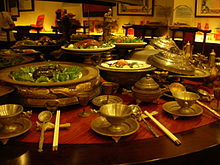Manchu Han Imperial Feast
| Manchu Han Imperial Feast | |||||||||||||||||||||||||||

Manchu Han Imperial Feast displayed at Tao Heung Museum of Food Culture
|
|||||||||||||||||||||||||||
| Chinese name | |||||||||||||||||||||||||||
|---|---|---|---|---|---|---|---|---|---|---|---|---|---|---|---|---|---|---|---|---|---|---|---|---|---|---|---|
| Traditional Chinese | 滿漢全席 | ||||||||||||||||||||||||||
| Simplified Chinese | 满汉全席 | ||||||||||||||||||||||||||
|
|||||||||||||||||||||||||||
| Vietnamese name | |||||||||||||||||||||||||||
| Vietnamese alphabet | Mãnhán toàntịch | ||||||||||||||||||||||||||
| Korean name | |||||||||||||||||||||||||||
| Hangul | 만한전석 | ||||||||||||||||||||||||||
| Hanja | 滿漢全席 | ||||||||||||||||||||||||||
|
|||||||||||||||||||||||||||
| Japanese name | |||||||||||||||||||||||||||
| Kanji | 満漢全席 | ||||||||||||||||||||||||||
| Kana | まんかんぜんせき | ||||||||||||||||||||||||||
|
|||||||||||||||||||||||||||
| Transcriptions | |
|---|---|
| Standard Mandarin | |
| Hanyu Pinyin | Mǎnhàn quánxí |
| Bopomofo | ㄇㄢˇ ㄏㄢˋ ㄑㄩㄢˊ ㄒㄧˊ |
| Wade–Giles | Man³han⁴ ch'üan²hsi² |
| Wu | |
| Romanization | Moe上hoe去 zie平zih入 |
| Hakka | |
| Romanization | Man²⁴hon⁵⁵ qion¹¹qiag⁵ |
| Yue: Cantonese | |
| Jyutping | Mun⁵hon³ cyun zik⁶ |
| Southern Min | |
| Hokkien POJ | Buánhàn tsuânsi̍k |
| Transcriptions | |
|---|---|
| Revised Romanization | Manhan jeonseok |
| McCune–Reischauer | Manhan chŏnsŏk |
| Transcriptions | |
|---|---|
| Romanization | Mankan zenseki |
Manhan Quanxi, literally Manchu Han Imperial Feast was one of the grandest meals ever documented in Chinese cuisine. It consisted of at least 108 unique dishes from the Manchu and Han Chinese culture during the Qing dynasty, and it is only reserved and intended for the Emperors. The meal was held for three whole days, across six banquets. The culinary skills consisted of cooking methods from all over Imperial China.
Quite a number of English names have been used to describe the dish combinations.
When the Manchus conquered China and founded the Qing dynasty, the Manchu and Han Chinese peoples struggled for power. The Kangxi Emperor wanted to resolve the disputes so he held a banquet during his 66th birthday celebrations. The banquet consisted of Manchu and Han dishes, with officials from both ethnic groups attending the banquet together. After the Wuchang Uprising, common people learned about the imperial banquet. The original meal was served in the Forbidden City in Beijing.
The meal was prepared comprising six banquets over three days with over 300 dishes. Altogether there are said to have been 196 main dishes and 124 snack dishes, for a total of 320 dishes sampled over three days. Depending on how the dishes are counted with the samples, at the absolute minimum there were 108 dishes. The Emperor, after previewing the dishes, gave the feast its present name. The feast was divided into inner-palace and outer-palace banquets; only the imperial family and meritorious officials, including Han officials above the second rank, were invited into the inner-palace banquets. A book from the Qianlong era gives a detailed description of the feast and the dishes and ingredients.
It is said that there were "Thirty-Two Delicacies", referring to the more exotic ingredients used for the banquet. The "Eight Mountain Delicacies" includes such dishes as camel's hump, bear's paws, monkey's brains, ape's lips, leopard fetuses, rhinoceros tails and deer tendons. The "Eight Land Delicacies" includes several precious fowls and mushrooms, and the "Eight Sea Delicacies" includes dried sea cucumbers, shark's fin, bird's nest and others.
...
Wikipedia
